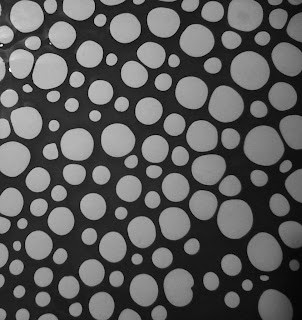 21.12.07
21.12.07
I returned to college on Monday this week as Michel from the French company was arriving at 8.00am on Tuesday morning. He came over to bring some equipment and materials and to demonstrate the infiltration process.
Alastair had completed a second tureen base, so I now had one set, plus a tureen with thin handles. The equipment was set up in the cold glass workshop, first experimenting on some test pieces of tureen. By the end of the day all was infiltrated, cured with the UV lamp and dried in the oven, or so I thought.
I carefully packed the two pieces and took them to Paris by Eurostar the following day. When Michel inspected the pieces he thought that they should have been cured and dried in the oven for longer. There were tell-tale blotchy patches which show the uneven curing. Michel had made a second lid for me, so in theory I have two tureens.
The day in Paris was spent making some tests for the black ceramic topcoat. Michel also proposed to make another tureen on their Z Corp machine using 131 powder as it is stronger than the 130 that College uses. It was decided to produce it in black to make the application of the topcoat far easier.
The following day I brought the test samples into College and compared them to a Wedgwood artists proof of an Eduardo Paolozzi Newton sculpture that is in the office. Surprisingly the colour that I thought would be the closest was far too dark, an iron oxide stain being far closer. I photographed the samples against the sculpture and emailed them to Gilles who planned to make up the colour in the lab and send me the results over Christmas.
The next stage will be to return to Paris to collect the pieces some time in January
Friday 21 December 2007
09 - The [almost] Complete Tureen
at
09:45
0
comments
![]()
Labels: Rapid Prototyping, RSA Ceramic Futures
Tuesday 11 December 2007
08 - The Tureen - first attempt
 When I came in to College this morning Alastair showed me the first attempt to make the tureen. It is very fragile, one of the handles had broken off and the design will need amending to provide additional strength to the weak areas, but it looked amazing. Once the design is made strong enough to infiltrate, it should become durable and I'll be able to take it to Paris next Wednesday for it's surface treatment.
When I came in to College this morning Alastair showed me the first attempt to make the tureen. It is very fragile, one of the handles had broken off and the design will need amending to provide additional strength to the weak areas, but it looked amazing. Once the design is made strong enough to infiltrate, it should become durable and I'll be able to take it to Paris next Wednesday for it's surface treatment.
at
17:35
0
comments
![]()
Thursday 6 December 2007
07 - Production testing
Before producing the final version there was a need to test the design. The tureen lid was used as the first section to be tested in production on a Z Corp 510 machine.
The result, though very delicate, was spectacular. There is a huge difference between exploring the virtual form on screen to engaging with the real thing.
 | 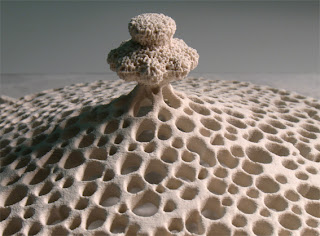 |
at
10:50
0
comments
![]()
Labels: Rapid Prototyping, RSA Ceramic Futures
Saturday 1 December 2007
06 - The Design/04
at
13:28
0
comments
![]()
Labels: artificial bone, Magics software
Friday 30 November 2007
05 - The Design/03
at
16:49
0
comments
![]()
Labels: artificial bone, photoshop
03 - The Design/01
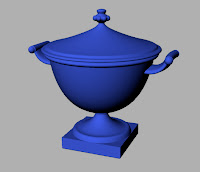 | 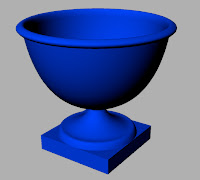 | 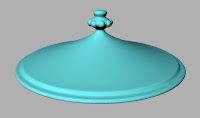 |  |
The tureen has been designed on Rhino 3D software. The files were then exported as .stl files that could be used in Magics software for transformation into the artificial bone structure.
at
15:36
0
comments
![]()
Labels: Rhino3D software
02 - The Project
Introduction:
Technology:
The technology used in this project is beginning to shape the way that objects are designed and made.
For instance a generic hearing aid has been designed which can be customised for each individual patient and produced with no extra tooling costs. The company Freedom of Creation can design an object literally in the back of a taxi, email the design to the manufacturer nearest to the client, who then collects it. The potential to reduce the amount of international and domestic freight is one of the potential benefits of RM.
Materials:
The materials used in this project have been developed by a company in France to convert prototypes made on the Z Corp RP machine into fully functional products. They are ceramic and glass materials that require no firing, yet possess the same properties as traditional materials. They can be applied to virtually any substrate and are non-toxic, food safe, acid and alkali resistant, form a gas barrier are frost proof etc.
Icons:
To demonstrate the use of these materials I decided to take an iconic object from the first Industrial Revolution and produce it using second Industrial Revolution techniques in a way that would have been impossible 200 years ago.
I chose to design a ceramic piece based on early C18th Wedgwood, chosen because Josiah Wedgwood was at the forefront of the first Industrial Revolution, introducing division of labour, helping to develop the canal system etc. The Design:
The Design:
My starting point was the 1817 Wedgwood Creamware catalogue. I chose to base my design on the lidded tureens, combining common elements. All my design work was done using Rhino 3D software.
Imitation:
Many manufacturers including Wedgwood produced ceramics that imitated other materials. I chose to imitate a material that couldn't be produced using conventional ceramic techniques. Artificial bone was chosen for it's interesting texture and because it is produced using RP.
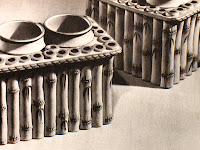 |  |  |
01 - Josiah Wedgwoodn't
Josiah Wedgwoodn’t have been able to undertake this project, but as one of the fathers of the first Industrial Revolution he would certainly be at the forefront of the second Industrial Revolution if he were here today.
The Second Industrial Revolution:
Rapid manufacture [RM] and rapid prototyping [RP] are methods of 3D printing using digital data. A range of materials, from plaster, starch and plastics through to some metals can now be fabricated with increased precision and speed. As yet there are few ceramic materials for use in RM.
The technology has advanced dramatically over the past twenty years and is talked about as the Second Industrial Revolution, yet the present stage of its development is the first Industrial Revolution equivalent to the year 1800.
My entry:
My entry for the RSA Design Directions Ceramic Futures competition uses RP and highly innovative ceramic materials to reproduce an iconic ceramic object from the first Industrial Revolution in a way that was impossible in the early 1800’s.
So read on..........


